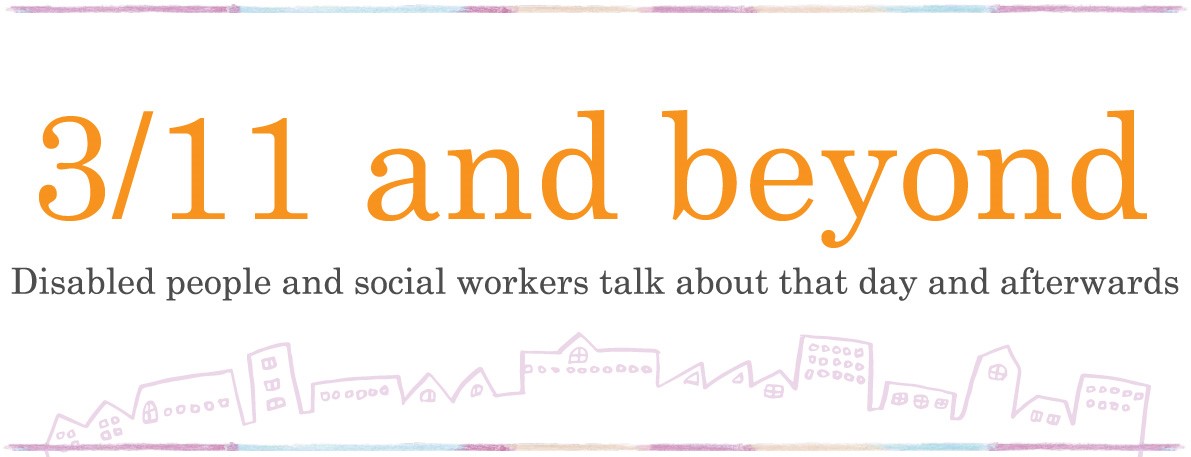Toilet
Disaster-vulnerable groups and the reality they faced 1
Disaster-vulnerable groups refer to people who need special help in a disaster. These people have difficulty evacuating on their own and need support. Of course, this means they also need special consideration after evacuating. Although they might have high priority on temporary housing lists, there isn’t even a place for them in shelters. For example, there is no consideration for those handicapped people who may have difficulties using general toilets, and they are not given first priority for spaces that accommodate their special needs. So disabled victims couldn’t stay, but had to find places other than shelters or live in cars. Then, if they weren’t living in shelters, they might not receive supplies and such. It became a never-ending cycle, and that was really exhausting at the time.
Troubles at the evacuation center
The first problem we had was food. We were also afraid we could die of weakness as we were wet after being swallowed by the tsunami. There was a stove that saved us because we could get warm. Otherwise things would have been much worse.
Then, one of our disabled trainees needed to use the toilet. The area in front of the biology laboratory was the school yard and it was full of cars, so there was no place to go. I remember the school made a temporary place for us at the back of the gym.
Pretty soon the women needed to use the toilet too. We made a toilet and gave them privacy by using the desks and curtains in the classrooms and turning off the lights of the cars in the yard. But it was cold and there wasn’t much privacy, so they didn’t feel comfortable and couldn’t go even though they had the urge.
Heartless words
Kayoko: There were a lot of people in the region who didn’t know this was a place for people with disabilities. So they thought it was strange that only we (at Kujira no Shippo) were getting special treatment. If there was a problem with the toilets, or they found someone who wasn’t following the rules properly, they would say, “I bet the Kujira no Shippo people did this.”
We didn’t want our trainees to feel hurt hearing all these negative words, so we thought, well there just happen to be toilets in another one of our buildings. We talked about it and decided that although it would be hard for our disabled trainees to walk over there, we would have someone go with them at nighttime to use it. But as we were doing this, the people around us gradually started to understand them (the trainees).
What inspired that understanding?
Kayoko: It was inspired by the shelter meetings we had in the mornings with everyone to determine the rules for managing the building (as a shelter). We had decided to set rules because this was a place everyone was using together. Kujira no Shippo also participated. Our trainees expressed their willingness to clean and do what they could just like everyone else, and when they started working together with the non-disabled people, the prejudice and misunderstanding went away.
But people would say things like, “Oh, so you can talk normally.” It’s really a shock to hear something like that from people who know nothing about disabilities.
I realized a lot of people think people with disabilities can’t do anything in life without help.
For example, once the abled people realized that if you told our trainees to line up and wait their turn, they could wait in line with everyone else, they started asking us to help when they needed more hands to distribute the relief supplies that arrived. Sometimes our staff and trainees would pair up to help, and that helped some people to gradually understand. We were happy when those people started talking to us and gradually losing their prejudice.
Life at the evacuation center
Members of our group were worried not to bother each other in one sense, and I believe many of them hold their feelings.
There were situations people looked irritated as we all had to endure very inconvenient life. When we don’t have anything to do, we tend to withdraw and feel irritated.
There was a new initiative at the evacuation center to use water from school’s swimming pool for the bath rooms as we didn’t have water to flush. We relayed water in buckets from the swimming pool to the bath rooms and kept it there for flushing. Relaying water became a routine of life at the center. Our trainees had opportunity moving and using their body in this routine. We volunteered to clean the floor space we were using at the school as well. We wanted to have some kind of assigned tasks to do.
Persons in charge of the evacuation center were very helpful and considerate. While basic rule was for all the evacuees to stay in a gym except for the ones who were certified as being in need of care, we were offered separate room just after one night in the gym. They spared a classroom for us. With about 40 adults lying on the floor, the room was packed and without enough space to walk around. Still, it was really a relief for us. We would have felt much more pressured if we had to be with other evacuees and had to watch our group not to bother others. It was very helpful and we appreciated it very much.
避難所へ
揺れが収まってから、建物から出る段階に移っていったと。
そうですね。ドア自体は開閉できるように抑えていたので、そこで閉じ込められることはなかったです。次に避難経路の確認ということで、イベントをしていた場所が非常階段に近いスペースだったので、一応確認してから皆さんと一緒に避難しました。階段なんかも、壁ににひびが入っていたり、天井からパラパラ小石が落ちてきたりした部分もあったんですが、大きく壊れているところはなかったので、そのまま裏口駐車場まで利用者さんに付き添っていきました。避難訓練をしていた時に自力で歩ける方々は先に降りて、スタッフの介助が必要な人たちが後から行くようにしました。
避難時に皆さんが履いていたのは内履きのような、運動靴のようなものですかね?
そうですね。
ガラスが割れたことはなかったですかね。
そうですね、ガラスが割れたことはなかったですね。イベントをしていたスペースはあまり荷物を置いてあるスペースではなかったので、何かが倒れてきたり、ものが散乱したりすることは無かったので、それはよかったですね。
40名を超える人がいらした状況で、全員の避難が完了したのが何時くらいだったか覚えていらっしゃいますか?
詳細な時間は記憶していませんが、みなさんスムーズだったと思います。パニックになるような人もいなかったので。みんな怖かったと思うので、速かったですよ、普段歩く以上に。
当時の利用者さんの年齢は、どのくらいの方が多かったですか?
今から7年前なので、30代くらいの方が多かったですかね。50代、60代の方もいらっしゃいましたが。
そうすると所定ルートを通って素早く行動できたと。その後は所定の広場のようなところに集まったということでしょうかね。
そうですね。裏口から出てすぐに駐車場がありましたので、そちらに避難していましたね。
その後の行動はどういった感じだったでしょうか?
そのあとはですね、駐車場と言っても建物から近いところだったので、そこからも少し離れて、隣の敷地のすぐそばに個人宅があるんですけど、カーポートをお借りして、雪を凌ぎながらいました。
それはやはり築50年というのが頭にあって、離れた方がいいだろうという判断ですか?
そうですね。建物の方には近づかないと。利用者さんのこだわりで自分の荷物を持ってこなきゃない、靴を持ってこなきゃないっていうのがあったんですけど、「危ないからやめてくれ」っていうのでそこは制止して。あとは揺れが収まって、必要な物品、例えば毛布だとかを職員が持ってこられるものは持ってくるから、みんなはここで待っててね、という形で職員が建物内に取りに行っていましたね。
近隣住民の方も避難していたと思うんですが、様子はいかがでしたか?
そうですね、みなさん外には出ていらしたと思いますが、一時避難で外に出たときはそれほど多くはいらっしゃらなかったですね。
そこから次はどうされましたか?
駐車場に出た段階で、各家庭への連絡をしてみましたが、回線がパンクしていてほとんどつながりませんでした。で、「災害伝言ダイヤル」の練習をこぶしでしていたので、そちらに伝言入力もしてみましたが、そちらもだめでした。実際にはどこにもつながらない状態でした。あとは16時くらいに、近くの長町小学校に避難しました。雪も降ってきて寒かったので。移動するときに、建物の裏側の入り口に「長町小学校に避難しています」の張り紙を残して、移動しました。
父兄の方々は、張り紙を見て長町小に迎えに来られた方もいましたか?
いらっしゃいましたね。長町小に行った時も人はもうすごく集まっていて、体育館も人でごった返していました。実際に利用者さんと行ってはみたけど「この中には入れないだろう」というので、スタッフの方に「障害のある方と避難してきたんですが、まとまって入れる場所はありませんか?」と相談をして、図工室の方に通してもらいました。
いろいろな事業所さんの取材の中で、「部屋の確保」を交渉する段階でトラブルがあったという話を聞くのですが、こぶしさんの方ではいかがでしたか?
多少の待ち時間はありましたが、トラブルはありませんでした。
その後長町小学校はどのくらい滞在されましたか?
一泊ですね。その間に張り紙を見て保護者の方がお迎えに来たり、たまたま連絡がついたご家庭の方に引き渡したりした事例もありました。
夜が明けてから、公用車で送迎しようということになりました。ガソリンも残っていたので。自家用車で来ている職員もいたので、方面を決めて利用者を送りながら職員も自宅に帰ることにしました。信号も付いていないところがほとんどだったので、もごすごく慎重に送っていきました。で、ご自宅に着いたものの不在で、お会いできなかった利用者さんの保護者さんもいらっしゃいました。お会いできなかった方は小学校まで戻ってきました。最終的には連絡が取れて、12日中には全員ご自宅に帰ることができました。
避難所で特に困ったことはありましたか?
お手洗いはみなさん気にしていましたね。水も流れないし、2日目くらいからは臭いの問題なんかもありましたね。そもそもあまりトイレに立つ方はいらっしゃいませんでしたが。
一般の方と同じトイレを使っていらした?
そうですね。
長町小学校は地域の指定避難所になっていたんですか?
はい。地域の方が避難してきていました。
では避難に必要な基本的な備品はそろっていたという状況でしょうか?
いえ、当日は何もなかったですよね、ただその場でお迎えを待つという感じで対応していました。
寒かったですよね。
事業所に毛布なんかも取りに行ったんですけど、清掃班のジャンバーとか、利用者さんの上着とか、あるものを使って暖を取っていました。体を寄せあったりもしてましたね。
停電もしていたので、不安の強い方とは手をつないだりもしていました。たまたま職員が懐中電灯を持っていたので、天井を照らしてうっすら明かりを確保することができました。
とにかく外部と連絡が取れる状況になかったので、とにかくそこに留まるしかないという状況でしたね。

